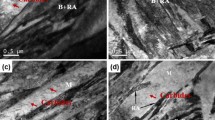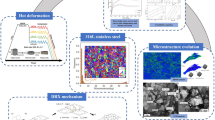Abstract
In the present work, the impact of cyclic loading conditions on the accumulation of stored energy in an austenitic steel is investigated. For this purpose, in situ X-ray diffraction analyses were carried out to estimate the stored energy density from integral breadths. Specifically, uniaxial cyclic tests were performed for different stress amplitudes, loading ratios and numbers of loading cycles. The Williamson and Hall method was used to evaluate the microstructural changes resulting from a loading history. The comparison with experimental data available in the literature suggests that the number of cycles to failure is not solely related to the stored energy density. Indeed, while the loading ratio impacts the number of cycles to failure, it has no visible influence on the stored energy density. Also, whatever the loading ratio is, energy is mostly stored during the first loading cycle. No significant evolution of the stored energy density is observed during the following loading cycles. Finally, experimental results indicate that the fraction of the work that is stored within the material is small, about a few percent for the investigated loading conditions.












Similar content being viewed by others
Notes
Strictly speaking, the interrupted tension test is not monotonic as the stress does not continuously increase during the test. However, since no significant static recovery occurs during interruptions, the results are similar to those obtained under strict monotonic loading conditions (see Figure 6).
References
G. Sines, J.L. Waisman, and T.J. Dolan: Behaviour of metals under complex static and alternating stress, in Metal Fatigue. G. Sines and J.L. Waisman, eds., McGraw-Hill, New York, 1959.
B. Crossland: Effect of large hydrostatic pressures on the torsional fatigue strength of an alloy steel. in Proceedings of International Conference on Fatigue of Metals, London, 1956, pp. 138–49.
K.D. Van: Sci. Tech. Armement, 1973, vol. 47, pp. 641–722.
E.Z. Stowell: Nucl. Eng. Des., 1966, vol. 3, pp. 32–40.
B.N. Leis: J. Press. Vessel. Technol., 1977, vol. 99, pp. 524–33. https://doi.org/10.1115/1.3454571.
T. Palin-Luc and S. Lasserre: Eur. J. Mech. A, 1998, vol. 17, pp. 237–51. https://doi.org/10.1016/S0997-7538(98)80084-3.
G.L. Rosa and A. Risitano: Int. J. Fatigue, 2000, vol. 22, pp. 65–73.
C. Doudard, S. Calloch, F. Hild, P. Cugy, and A. Galtier: CR Mécanique, 2004, vol. 332, pp. 795–801.
R. Munier, C. Doudard, S. Calloch, and B. Weber: Int. J. Fatigue, 2014, vol. 63, pp. 46–61. https://doi.org/10.1016/j.ijfatigue.2014.01.004.
V.V.C. Wan, D.W. MacLachlan, and F.P.E. Dunne: Int. J. Fatigue, 2014, vol. 68, pp. 90–102. https://doi.org/10.1016/j.ijfatigue.2014.06.001.
B. Chen, J. Jiang, and F.P.E. Dunne: Int. J. Plast., 2018, vol. 101, pp. 213–29.
J. Warren and D.Y. Wei: Int. J. Fatigue, 2010, vol. 32, pp. 1853–61. https://doi.org/10.1016/j.ijfatigue.2010.05.003.
J. Lemaitre, R. Desmorat, and M. Sauzay: Eur. J. Mech. A, 2000, vol. 19, pp. 187–208.
J. Lemaitre and R. Desmorat, eds.: Engineering Damage Mechanics: Ductile, Creep, Fatigue and Brittle Failures, Springer, Berlin, 2005.
M.B. Bever, D.L. Holt, and A.L. Titchener: Prog. Mater. Sci., 1973, vol. 17, pp. 833–49.
L.M. Clarebrough, M.E. Hargreaves, G.W. West, and A.K. Head: Proc. R. Soc. Lond. Ser. A, 1957, vol. 242, pp. 160–66.
G.R. Halford: Stored energy of cold work changes induced by cyclic deformation. PhD Thesis, University of Illinois, 1966.
A. Chrysochoos, A. Blanche, B. Berthel, and B. Wattrisse: Energy balance properties of steels subjected to high cycle fatigue, in Thermomechanics and Infra-Red Imaging. T. Proulx, ed., Springer, New York, 2011, pp. 39–58.
C. Mareau, D. Cuillerier, and F. Morel: Mech. Mater., 2013, vol. 60, pp. 93–106. https://doi.org/10.1016/j.mechmat.2013.01.011.
M. Taheri, H. Weiland, and A. Rollett: Metall. Mater. Trans. A, 2006, vol. 37A, pp. 19–25.
S.S. Hazra, A.A. Gazder, and E.V. Pereloma: Mater. Sci. Eng. A, 2009, vol. 524, pp. 158–67. https://doi.org/10.1016/j.msea.2009.06.033.
N. Rajmohan, Y. Hayakawa, J.A. Szpunar, and J.H. Root: Acta Mater., 1997, vol. 45, pp. 2485–94. https://doi.org/10.1016/S1359-6454(96)00371-0.
M.H. Loretto, M.E. Hargreaves, and L.M.J. Clarebrough: Aust. Hlst. Met., 1963, vol. 8, p. 127.
V. Mote, Y. Purushotham, and B. Dole: J. Theoret. Appl. Phys., 2012, vol. 6, pp. 1–8. https://doi.org/10.1186/2251-7235-6-6.
G.R. Stibitz: Phys. Rev., 1936, vol. 49, p. 862.
A. Teklu, H. Ledbetter, S. Kim, L.A. Boatner, M. McGuire, and V. Keppens: Metall. Mater. Trans. A, 2004, vol. 35A, pp. 3149–54.
O.W. Dillon: Plastic deformation waves and heat generated near the yield point of annealed aluminum, in Mechanical Behavior of Materials Under Dynamic Loads. U.S. Lindholm, ed., Springer, Berlin, 1968, pp. 20–61. https://doi.org/10.1007/978-3-642-87445-1_3.
L. Vincent: Eur. J. Mech. A, 2008, vol. 27, pp. 161–80.
L. Fang, W. Zhao, Y. Wei, Q. Zhang, L. Zhang, N. Ali, H. Zhou, and H. Wei: Mater. Res., 2022, vol. 25, pp. 1–8. https://doi.org/10.1590/1980-5373-MR-2021-0401.
M. Mineur: Conditions locales d’amorçage des fissures de fatigue dans un acier inoxydable de type 316L : aspects cristallographiques (EBSD). PhD Thesis, Université de Poitiers, 2000.
R. Guerchais: Influence d’accidents géométriques et du mode de chargement sur le comportement en fatigue à grand nombre de cycles d’un acier inoxydable austénitique 316L. PhD Thesis, École nationale supérieure d’arts et métiers, 2014.
J. Peng, Y. Gao, Q. Dai, Y. Wang, and K. Li: Acta Metall. Sin., 2019, vol. 55, pp. 773–82.
J.E. Bailey and P.B. Hirsch: Philos. Mag., 1960, vol. 5, pp. 485–97. https://doi.org/10.1080/14786436008238300.
A.A. Benzerga, Y. Bréchet, A. Needleman, and E.V. Giessen: Acta Mater., 2005, vol. 53, pp. 4765–79.
L. Kubin, B. Devincre, and T. Hoc: Acta Mater., 2008, vol. 56(20), pp. 6040–49. https://doi.org/10.1016/j.actamat.2008.08.012.
Author information
Authors and Affiliations
Corresponding author
Ethics declarations
Conflict of interest
On behalf of all authors, the corresponding author states that there is no conflict of interest.
Additional information
Publisher's Note
Springer Nature remains neutral with regard to jurisdictional claims in published maps and institutional affiliations.
Appendix A Relation Between the Integral Breadth of Diffraction Peaks and the Stored Energy Density
Appendix A Relation Between the Integral Breadth of Diffraction Peaks and the Stored Energy Density
Equation [2] exploits the relation between the width of diffraction peaks and the stored energy. Indeed, according to the Bragg equation, the lattice spacing \(d_{hkl}\) associated with a \(\{hkl \}\) set of equivalent planes is related to the Bragg angle \(\theta _{hkl}\) with:
The differentiation of the above equation allows relating the variation of lattice spacing \(\Delta d_{hkl}\) to the width of diffraction peaks \( \Delta 2 \theta _{hkl}\) according to:
In the above equation, \(\Delta d_{hkl}/d_{hkl}\) can be interpreted as the root mean square strain resulting from the internal stress field produced by lattice defects. Since energy storage in crystalline materials is mostly controlled by lattice defects,[25] proposed to estimate the stored energy from \(\Delta d_{hkl}/d_{hkl}\) with:
However, in a typical diffraction experiment, the width of diffraction peaks includes an instrumental contribution, which does not provide any information on the microstructure. To exclude such a contribution,[22] used a modified version of Eq. [A2]:
where \(\Delta 2 \theta _{0,hkl}\) is the peak width measured for an annealed specimen with negligible stored energy. In the present work, an equivalent form of the above equation, which is based on reciprocal quantities, is used. The reciprocal lattice spacing \(d^\star _{hkl}\) and the reciprocal integral breadth \(\beta ^\star _{hkl}\) are given by:
Combining the above relations leads to the following equation:
Equation [2], which relates the stored energy density to the reciprocal integral breadth, is obtained by introducing the above expression in Eq. [A3].
Rights and permissions
Springer Nature or its licensor (e.g. a society or other partner) holds exclusive rights to this article under a publishing agreement with the author(s) or other rightsholder(s); author self-archiving of the accepted manuscript version of this article is solely governed by the terms of such publishing agreement and applicable law.
About this article
Cite this article
Mareau, C., Hatte, Q. Evolution of the Stored Energy Density in a X2CrNiMo17-12-2 Austenitic Steel Under Cyclic Loading Conditions. Metall Mater Trans A (2024). https://doi.org/10.1007/s11661-024-07369-w
Received:
Accepted:
Published:
DOI: https://doi.org/10.1007/s11661-024-07369-w




